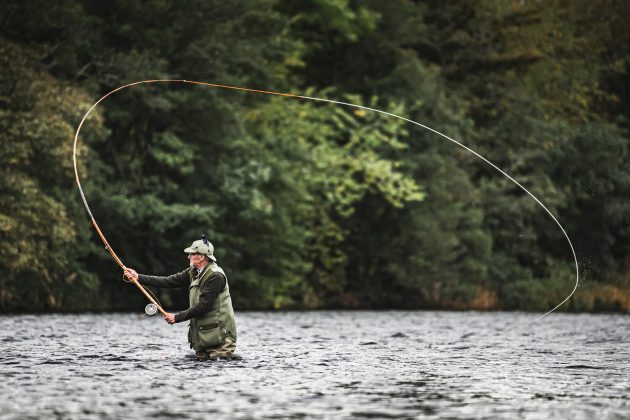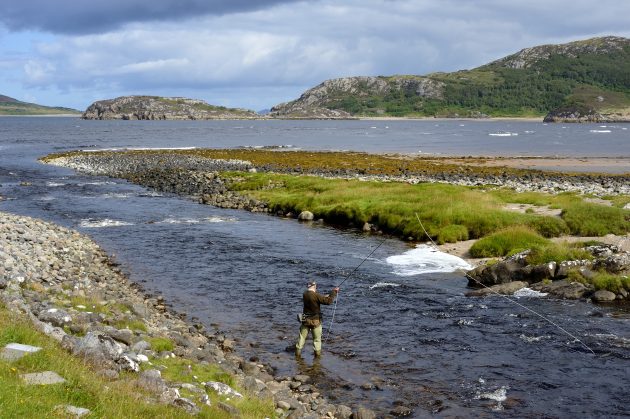The back end of the season commences when the weather changes, awaking salmon from their torpor and giving Scotland its most productive fishing period says Mungo Ingleby
September can be a glorious month for salmon fishing. After weeks of potentially dry and dusty weather, reliable rains sweep in from the west and, finally, our rivers will again run high and cool. Spring and summer fish, which have been hunkered down in bad humour and uncatchable, wake from their torpor. Flies that have passed largely unseen and ignored are taken with enthusiasm and aggression, and the back end (as September to the end of the season is known) remains Scotland’s most productive fishing period. It is this time when the year’s full quota of fish are in the pools and any day when water levels are up and salmon are sloshing around should be cherished.

From a fishing perspective, the autumn period is a movable feast. It commences the moment the weather changes, as meaningful rain starts to fall and water temperatures begin to drop. In 2022, this was around 10 September, while in 2021 it started later with prolonged rain not settling over Scotland until 25 September. Alternatively, in some years we have had gloriously (for an angler) wet summers. In 2023, many rivers have already had two if not three July spates. In a worst-case scenario the weather might not break until we are well into October. Generally, however, there is a block of weeks with reliably dependent water from mid-September through to season close.
During this period, you will be predominantly fishing for salmon that ran through the spring and summer months, or those that have been loitering in the tidal reaches. Sadly, the run of large fresh fish that filled our rivers in the autumn months has been largely absent since 2014, although you will still see and catch the occasional silver straggler. This is the case whether you are on Tweed or the Thurso and it means that, where once the focus would be on the south and east (the ‘autumn’ rivers), the net can now be cast wide and any river has the potential to give you a great season send-off.

WHERE TO GO
Finding the right slot, beat and river is, as always, a thorny problem. Daily catches and monthly, even weekly, averages offer only the loosest of pointers. The budding statistician would need the conditions to go along with the catches, perhaps a note on the ability of the fishers on the river and whether they lunched long or had a piece on the hoof. In the autumn, think more on what is important to you beyond the fish themselves. Do you want to stay in a hotel, lodge or cottage? Is the length of beat key or the size of the river? How many friends do you wish to fish with? There are many things to ponder and having done so a simple internet search of the river name in question will generally reveal the available beats and options. However, there are some pointers it is worth following to ensure the best chance of success.

Low summer flows don’t prevent fish creeping into the lower Tay, Tweed and Spey. They may well remain and even spawn here, or suddenly decide to move en masse on the second or third flood and shoot straight to the upper reaches. This can leave relatively slim pickings for the middle reaches, but every year is different. The lower reaches of the Spey, the run of Tay beats from the junction of the Isla down towards Perth, and the lower (perhaps not bottom) and upper beats of Tweed offer the opportunity to cast a long line with the prospect of a heavy autumn fish stopping the fly in its tracks.
The Don, Deveron, Teith and Esks are delightful, medium-sized east coast rivers that miss the autumn run. Nevertheless, there are some beautiful and affordable beats across these rivers and the autumn months sometimes reveal that a surprising number of fish must have run, almost undetected, through spring and summer. The Deveron, Teith and North Esk all offer the opportunity of an autumn lunker.
Bright, spate-ier streams that are transformed with water include the Findhorn, Carron, Brora, Helmsdale, Oykel, Alness and Cassely. Gone is the stealthy first and last light approach of summer and instead runs that might have offered five yards of fishing in the summer months are transformed into 100-yard-long pools. All these rivers, and more, can offer great fishing and it is magical to see these rivers with water. The Carron also had a small run of fresh September fish in 2022.

For some of the strongest runs of fish in the country, visit the Thurso, Halladale, Naver and Borgie. Some are harder to access than others but you will never find an opening if you do not make an enquiry. Every year there are vacancies and a cast in the far north with dropping temperatures, a cool southerly wind and a box of Willie Gunns is a real marker of autumn.
On the west coast, the Inver and the Kirkaig, the Gruinard, Lochy, the Ullapool at Rhidorroch, Broom, Kinlochewe and others are more than just an autumn cast. They vary in size from the steep and narrow Kirkaig, where a 12ft or 13ft rod is the best choice, to the much wider Lochy where a 15ft rod is required. These west coast rivers flow through stunning country, which holds roaring stags in the hills and as an additional bonus there are rather fewer leaves than on the east coast. The Kirkaig and Lochy, in particular, offer the opportunity of a fish of a lifetime.

Having found your beat, you now need to catch a fish or two. When it comes to tactics I will skip past the horror of your trip coinciding with an extended Indian summer. Low water, high temperature and listless September, even October, residents are a desperately difficult and disappointing combination. A small hitch and a stiff drink is often the best medicine.
What both fish and fisher are hoping for is falling temperatures and lots of rain. After the summer’s accumulation of weed and muck has been washed away and the water runs clear, it is actually difficult (in particular on our smaller rivers) to have too much water. If you do have the hoped-for conditions of high water, adopt a multi-rod approach, one with a floater and a tip and another with a line that gets a little deeper. Fish quickly and at different depths.
WHAT FLY TO USE?
Fly choice isn’t rocket science and everyone has their tried and tested favourites but, generally, less flash is better than more, and smaller is better than big. The innumerable variations of the Cascade, Park Shrimp and Ally Shrimp, perhaps with yellow hues substituted for reds, together with the Willie Gunn are a good place to start. Having a mix of doubles, small copper tubes and brass and tungsten coneheads is every bit as important as having a mix of patterns. Note that while cooler, in the current climate September and October water, even when thundering down the strath or glen, is rarely cold. In October, let alone September, frosts are rare and even in big water a shrimpy size 10, or half-inch tube, will often outfish larger offerings.

At the end of the season there will be no shortage of small, reddish, shrimpy flies traversing the river. If favourites fail it can pay to try something different. For a second run down a pool, try changing the depth of presentation as well as the fly. This is when a second rod comes in handy. It is so much easier than changing your line and you will catch more fish. A second-choice fly might be something much larger, a Red Francis with its irritating feelers or a simple large red or all-black tube swung slowly and at depth. Never forget a Sunray – pink and purple flies can be surprisingly effective – and a Black Brahan or tiny Silver Stoat on a dropper will, on its day, catch fish after fish.
There is no doubt that leaves can be an exasperating menace. There are, however, ways to limit the frustration. They are often largely on and in the surface layer and if you swing a double on a light tip, it will likely catch a leaf. If, however, you use a heavy fly, tip or line, with a yard of slack in the cast, it is often possible to get your fly quickly below them and swing it into relatively clear water. Other ploys include fixing the hook of any tube so that it points upwards, shielded by the wing, or by using a slightly smaller hook on a snaelda-type fly. A snappy spey cast will also detach a leaf from a single hook where it might remain stubbornly attached to a double. If the entire river column is leaf soup it might be best to retire. Those who execute an initial spey cast to reposition the line in front of them will also quickly be driven mad.
Falling water temperatures quite likely make the later weeks a less stressful moment to be caught (if you happen to be a salmon) than the hotter summer months but it is imperative that the autumn fisher takes care of the river residents. Use strong nylon, play hooked fish hard, really hard, rods are made to bend, and after you hustle them to the bank keep the fish in the water. If your fish does not shoot off on release, support it in the current until it does so and play the next one harder.
Lastly, there is a moment in every year, which differs from river to river, whether it is season end or not, when it becomes apparent that it is time to wind in and leave the fish in peace and the riverbanks quiet.
Mungo Ingleby is the director of Ossian Sporting Lets. Instagram: @sportinglets




